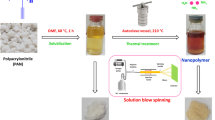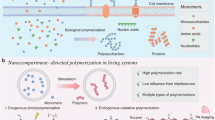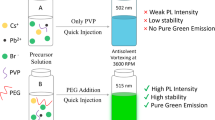Abstract
A facile synthesis for nanosized conducting polymers with inherent self-stability and multi-functionalities is a main challenge. Here we simply synthesize intrinsically self-stabilized nanofibril bundles of poly(1-anthraquinoylamine) (PAQ) by a template-free method. The critical polymerization parameters were studied to significantly optimize the synthesis, size, properties, and functionalities of the resulted fine nanofibrils with a diameter of ca. 30 nm and length of ~6 μm. The PAQ obtained with ammonium persulfate possesses higher polymerization yield, purer composition, higher conductivity, better melting behaviour, higher thermostability, lower burning enthalpy, and slower degradation than that with other oxidants. Furthermore, the polymer nanofibrils exhibit high self-stability, powerful redispersibility, high purity, and clean surface because of a complete avoidance of the contamination from external stabilizer. The PAQ exhibits widely controllable conductivity moving across ten orders of magnitudes from 10^-9^ to 50 S/cm, photoluminescence, lead-ion adsorbability, very high thermostability in air and extremely high char yield in nitrogen at 1000˚C. These materials would be useful as advanced materials including photoluminescent materials, highly cost-effective carbon precursors, sorbents of toxic metal ions, and cost-efficient conductive nanocomposite with low percolation threshold.
Similar content being viewed by others
Article PDF
Author information
Authors and Affiliations
Corresponding author
Rights and permissions
About this article
Cite this article
Li, XG., Huang, MR., Li, H. et al. Facile Synthesis and Versatilities of Polyanthraquinoylamine Nanofibril Bundles with Self Stability and High Carbon Yield. Nat Prec (2008). https://doi.org/10.1038/npre.2008.2396.1
Received:
Accepted:
Published:
DOI: https://doi.org/10.1038/npre.2008.2396.1



